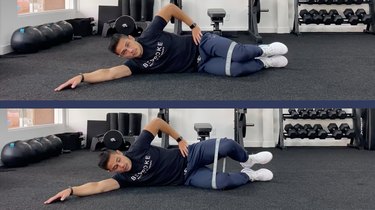

When it comes to building strong, peach-emoji-style glutes, hip thrusts get all the attention. But for the most well-rounded fruit, clamshells are the lesser-known MVP.
- What is the clamshell exercise? The clamshell is a side-lying exercise that involves opening and closing your knees to strengthen your glutes. When done correctly, your legs look like a clam opening and closing.
- What muscles does it work? It mainly strengthens your gluteus medius and maximus, according to California-based physical therapist Jereme Schumacher, DPT. You should feel it in the sides and tops of your top leg's glutes. It also helps improve hip flexor strength and core stability.
- Who can do clamshells? This glute strengthener is great for any fitness level. You can even use it for injury recovery or prevention (more on that below).
Video of the Day
Already impressed with all this exercise has to offer? Make like the clam and learn all you need to know about this must-try move.
How to Do the Clamshell Exercise With Perfect Form
- Loop a mini resistance band right above your knees and lie on one side. Stack your legs on top of one another, knees and hips bent at 90 degrees.
- Press your bottom leg into the floor and, with your heels pressed together, squeeze your glutes to raise your top knee toward the ceiling.
- Raise your knee as high as you can without letting your pelvis rock forward or backward.
- Pause, then slowly lower back to the starting position and repeat.
- Do all reps, then switch sides.
Watch the Full Clamshell Tutorial
Tip
To make this exercise easier, do it without a resistance band.
3 Benefits of the Clamshell
The clamshell offers plenty of perks, including injury prevention and strength-building. And considering it's friendly for all levels, this move can (and probably should) be part of your weekly workout routine.
1. It Strengthens Often-Missed Muscles
Squats, deadlifts even hip thrusts all work the glutes, but they focus on the gluteus maximus and can leave out the gluteus medius. Medium-sized muscles at the top of your glutes, the medius wrap around the outside of your hips and are a big part of building a balanced backside.
Strengthening and grow the glute medius helps you run faster and lift heavier. It even stabilizes your legs to reduce your risk of hip, knee and ankle injuries when running, according to a February 2020 review published in the Strength & Conditioning Journal. It also gives your backside a rounder, higher, fuller look.
2. It's a Great Warm-Up Move
Clamshells have a way for waking up sleepy glute muscles, Schumacher says, who recommends doing them as a pre-workout activation exercise.
By getting your muscles fully firing before you head into a set of squats or a hard run, activation moves set you up the best success during all-out efforts, according to a July 2017 study in the BMJ Open Sport & Exercise Medicine. In short, activating your glutes during your warm-up can give you more out of your workout.
3. It Can Help Rehab
Physical therapists commonly use the clamshell exercise for knee pain and to help people recover after lower-body injuries, Schumacher says. After all, in addition to training that all-important glute med, they let you work each side individually. And you even do them lying down.
That said, follow your doctor's orders before adding any of your own exercises to your physical therapist's plan.
2 Common Clamshell Mistakes
1. Rocking Your Torso
During the exercise, it's easy to rock your torso or top hip back behind you to help raise your knee. Don't do it! It takes the good stress off of your core, hips and glutes, so you don't get as much muscle-strengthening benefits, Schumacher says.
Fix It
Think about keeping the side of your top hip facing the ceiling the entire time you do this exercise, Schumacher says. To remind yourself of this cue, you can place your top hand on your hip. It shouldn't move.
2. Using Too Tight of a Band
Although you may be eager to make this exercise as hard as possible with an extra-tight band, don't rush it, Schumacher says. Using too tight of a band can lead to poor movement patterns and reduce the move's effectiveness.
Fix It
Before doing the full-out move, practice the move as a strict body-weight exercise without a band. When you can comfortably do several sets of 10 to 12 reps, feel free to add a light band, Schumacher says. Increase your number of reps before reaching for a tougher band. Gradually progress to a medium and then heavy band only if you can still move with control and not use momentum.
4 Clamshell Exercise Variations for Every Glute Workout
To make this glute strengthener more challenging or mix up the muscles you work, try these alternatives. For the best results, do clamshell variations at least twice per week.
1. Do the Reverse Clamshell
For this move, get in the normal starting position. Then, instead of pressing your heels together and lifting your top knee, keep your knees together and raise your top foot toward the ceiling, Schumacher says.
This variation targets the gluteus minimus, the last of your three gluteal muscles. Perform it alongside standard clams to best build your side glutes.
2. Hold a Side Plank
Come into the same starting position, but with your upper body in a modified side plank. Keeping your lower knee on the floor, raise your top knee per usual.
This advanced clamshell variation will not only target your lower body, but increase core strength, too, according to Schumacher.
3. Raise Your Whole Leg
To increase the amount of resistance you're working against, Schumacher recommends raising your entire top leg, not just your knee. Keep your bottom leg flat on the floor, hips aligned and knees bent.
4. Sit Down
The seated clamshell exercise is an ideal alternative for anyone who doesn't want to lower down onto and get back off of the floor to work their side glutes.
For this modification, sit down on the edge of a sturdy chair with the band around your thighs and your feet together. Contract your glutes to move one or both knees out to the side at a time.